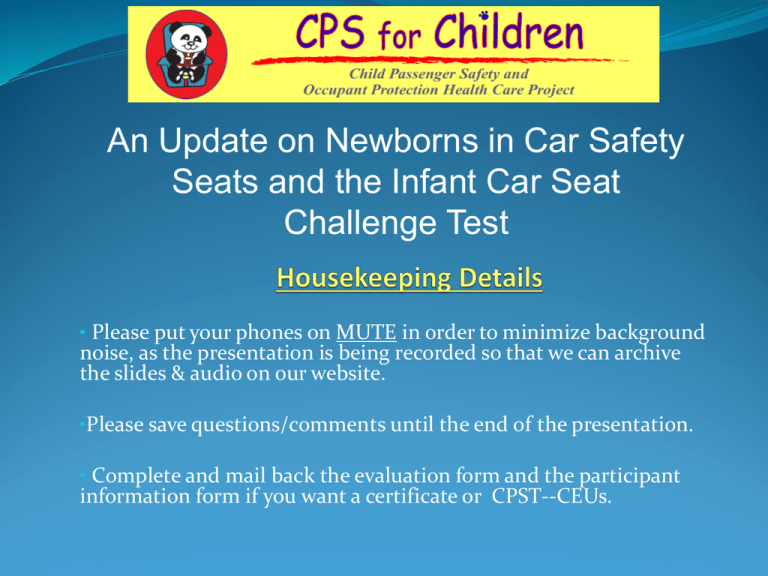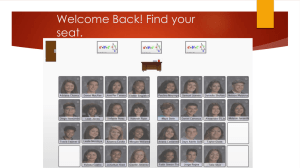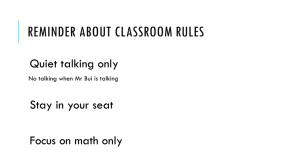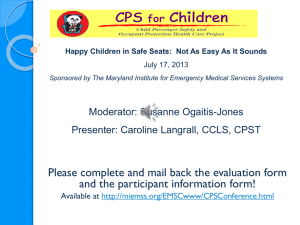An Update on Newborns in Car Safety Seats and the Infant
advertisement

An Update on Newborns in Car Safety Seats and the Infant Car Seat Challenge Test • Please put your phones on MUTE in order to minimize background noise, as the presentation is being recorded so that we can archive the slides & audio on our website. •Please save questions/comments until the end of the presentation. • Complete and mail back the evaluation form and the participant information form if you want a certificate or CPST--CEUs. Today’s Presenters Natalie L. Davis, MD, MMSC, Assistant Professor of Pediatrics, University of Maryland Hospital for Children; Claire Myer, MS, CPST/I, Assistant Coordinator, Maryland Kids in Safety Seats Susanne Ogaitis-Jones, MSPH, CPST, Coordinator, MIEMSS CPS Healthcare Project Child Passenger Safety What we know, what we use, and what we do has changed dramatically! We’ve Come A Long Way – for Baby! Changes to Rear-Facing Only and RF Convertible Car Seats More Rear-Facing Only seats with a weight minimum of 4 lbs vs 5 lbs Some Rear-Facing Convertible seats have a 4 lb minimum weight; 1 RF Convertible has a 3 lb min. Lower shoulder slot heights: 5.5” up to 8.5” Multiple crotch buckle positions for proper harness fit Manufacturer supplied LBW infant kits, “pillows”, foam inserts, wedges, and smaller harness retainer clips Car Bed Options for Infants Who Must Lie Flat Dream Ride SE Angel Ride 5 – 20 lbs Birth – 9 lbs 19 – 26” <21.5” Hope 4.5 – 35 lbs 13 – 29” Infant Car Seat Challenges: Who, What, When, Where, Why and How? Natalie Davis, MD, MMSc Assistant Professor of Pediatrics University of Maryland School of Medicine Division of Neonatology Objectives • Why do this test? History of the ICSC • Current recommendations on who should be tested • What failure guidelines should be used? • What to do when a baby fails? • Where is future research focusing? • How should we counsel families when it comes to ICSCs Why? Who? Why do this test? (History of the ICSC) Who should be tested? Infant Car Seat Challenge (ICSC) • 1970s – AAP recommends infants travel in a car safety seat • 1980s – Evidence that preterm infants at increased risk of desaturations while in the semi-upright car seat position – Lung immaturity? Breathing immaturity? Low tone? – Too small for the standard seat? • 1990s – AAP recommends “a period of observation for apnea, bradycardia and desaturations” in the car seat prior to discharge for preterm infants Infant Car Seat Challenge • 2000s – Evidence that longer time in car seat increases risk of desaturations • 2009 – Current AAP recommendations: – All infants born <37 weeks – 90-120 minutes, or length of car ride home, whichever is longer – No guidelines for “failure” criteria Bull MJ, et al. Pediatrics. 2009; Willett. Pediatrics. 1986 and 1989; Salhab. J Pediatr. 2007 Local Statistics • Premature: born <37 weeks gestation – “Due date” is usually 40 weeks • USA: 11.5% of babies are born prematurely – 500,000 born prematurely in the US annually • Maryland: 12.2% • Baltimore City: 13.7% – Maryland Dept of Health and Human Hygiene, 2012 Vital Statistics http://en.wikipedia.org/wiki/File:Maryland_in_United_States.svg Who? • All babies born <37 weeks gestational age (GA) – Overall failure rate of 4.3% • 2.4% in infants born early preterm <34 weeks GA • 5.6% in late preterm born 34+0/7 – 36+6/7 weeks GA • Who else? – – – – Full term babies born <2.5kg Respiratory issues (home oxygen, airway malformations) Hypotonia/neurologic issues (Trisomy 21, Prader Willi) Cyanotic Heart Disease • 6% failure rate (all full term) Davis NL, et al. Pediatrics 2013; Simsic JM, et al. Pediatr Cardiol 2008 ICSC: What’s Missing? • No guidelines for what constitutes an ICSC “failure” • When to perform the test? – When prior to discharge – In relation to feeds • Consensus on other groups to test – Low birth weight <2.5kg? Hypotonia? • What to do if an infant fails? • What does a “failed” infant car seat challenge mean for the health and safety of that baby? What? What failure guidelines should be used? Results • Following AAP Guidelines – 11% did not perform ICSCs – 17% did not test all infants born <37 weeks GA – 45% tested for <90 minutes • Additional Criteria – 45% included “Low Birth Weight” as a testing criterion, testing all babies born <2.5kg – No consensus on failure criteria for bradycardia or desaturations Davis NL, et al. Academic Pediatrics. 2013 ICSC Desaturation Failure Criteria 40% 35% 30% Percent of NICUs >60sec >30sec 25% >20sec 20% >10sec >5sec 15% Any 10% 5% 0% "Desat" <80% <85% <86% <87% <88% <89% <90% <91% <92% <93% Failure Saturation Davis NL, et al. Academic Pediatrics. 2013 ICSC Desaturation Failure Criteria 40% 35% 30% Percent of NICUs >60sec >30sec 25% >20sec 20% >10sec >5sec 15% Any 10% 5% 0% "Desat" <80% <85% <86% <87% <88% <89% <90% <91% <92% <93% Failure Saturation Davis NL, et al. Academic Pediatrics. 2013 ICSC Desaturation Failure Criteria 40% 35% 30% Percent of NICUs >60sec >30sec 25% >20sec 20% >10sec >5sec 15% Any 10% 5% 0% "Desat" <80% <85% <86% <87% <88% <89% <90% <91% <92% <93% Failure Saturation Davis NL, et al. Academic Pediatrics. 2013 Conclusions • Many NICUs not following AAP guidelines • Lack of consensus on clinically significant desaturation criteria • If the ICSC does in fact detect significant desaturations, current testing protocols may be missing at-risk infants • Differential care based on hospital of birth, not on clinical differences Suggested Failure Criteria • • • • Apnea >20 seconds Heart Rate <80 beats per minute for >10 seconds Saturation <90% for >10 seconds Respiratory distress not improved with proper positioning • Canadian Paediatric Society: – Two episodes <88% for >10 seconds When? What to do when a baby fails? Why do they fail? • Likely multifactorial – Lung immaturity/inflammation • Low reserve, small lung capacity – Low tone and strength • Floppy, easily malpositioned, unable to correct neck flexion • Straps compress the chest – Small size • Poor fit in car seat - neck flexed/occlude airway • Straps hit incorrectly – Neurologic immaturity and increased risk of apnea • Poor response to low oxygen saturations What does ICSC failure mean? • Failed ICSC – No studies on long term outcomes in infants that fail ICSC – Marker of immaturity? Need for closer monitoring? • Increased incidence SIDS in upright position? Related? • Passed ICSC – 89% positive predictive value of passing 2 subsequent tests – 11% passed, then failed a test • Lower weight • Educate families that a passed test does not mean 100% safety – still need to: – Position correctly – Monitor closely – Minimize time in the car seat position! Davis NL, Gregory ML, Rhein L. J Perinatol. 2014 Failed ICSC: What are the options? • Retest in car seat after a period of observation – Immediately – 6 hours – 12 hours – 24 hours • Test in car bed and d/c in car bed • Admit for further work up http://injury.research.chop.edu/sites/default/files/car_bed.jpg Safety: Car Seat vs. Car Bed 150 VLBW babies born <37 weeks gestation Tested in car bed and car seat for 120 minutes Randomly assigned to one, then re-tested in the other mode Car Seat Car Bed 15% had an event One needed test stopped Time to first event: 55 minutes 19% had an event One needed test stopped Time to first event: 54 minutes 28% had an event in BOTH Same number had events after 60 minutes and 90 minutes Same number needed nursing intervention Salhab WA, et al. J Peds 2007 Failed ICSC…what next? • No evidence that apnea, bradycardia, and desaturation episodes are less likely in a car bed than a car seat • Protection provided by a rear-facing car safety seat is better documented than the protection provided by car beds • If possible, safest to send them home in a car seat – Wait 12-24 hours and retest in car seat • Evaluate positioning during the test – location of straps, position of body • Evaluate car seat for proper sizing – If fails x2, further evaluation • Consider medical evaluation (any treatable cause? Persistent apnea?) • Discuss with family – retest in car seat • Consider testing in car bed and discharge in car bed – If fails test in car bed • Further medical evaluation for cause of respiratory/neurologic distress ICSC Pass Fail Discharge in approved car safety seat Wait > 12-24 hours and repeat ICSC 2nd Fail Pass Discharge in approved car safety seat Test in a Car Bed Pass Discharge in Car Bed Return for retesting in car seat at term or 2-4 weeks of age Fail Recommend further evaluation and admission for medical work up IF you must send them home in a car bed… • Perform a similar period of observation (Infant Car Bed Challenge, ICBC) prior to discharge • Before transitioning from a car bed to car seat, perform ICSC in the infant’s own semi-reclined car safety seat – At term equivalent (40 weeks) or 2-4 weeks after discharge – Repeat via pediatrician’s office or at pediatric pulmonologists office • Test in outpatient clinic • Test as inpatient with polysomnography Where? Where is future research focusing? Future Research • Incidence and risk factors for failure of the ICSC in full term, low birth weight (<2.5kg) babies • Recorded oximetry prior to the ICSC to predict failure • Inserts to improve oxygenation in the car seat • ICSC in all infants? How? How should we counsel families? Best Practice for ICSC • Discuss the test with the family and the reasons for performing it BEFORE the test. – Performed on premature babies and babies with other issues that put them at risk of breathing problems – Goal is to make sure their breathing is safe in that position before they go home – How long is their car ride home? • Bring in car seat well before anticipated discharge – NICU: 2-3 days before discharge – Full term nursery: bring in as soon as they can – Assess for safety of the seat, appropriate sizing Best Practice for ICSC • Test can be done any time of night or day, but make sure parents are aware – Perform >24 hours of life – Ideally perform day prior to discharge • Perform a “realistic” ICSC – recreate what will be happening at home – Perform within 30 minutes of a feed – Ok to use pacifier if the family will be using this at home – Use family’s actual car seat Suggested Failure Criteria • • • • Apnea >20 seconds Heart Rate <80 beats per minute for >10 seconds Saturation <90% for >10 seconds Respiratory distress not improved with proper positioning • Canadian Paediatric Society: – Two episodes <88% for >10 seconds Failed ICSC • Assess for fit of infant in car seat, appropriateness of positioning • Update family • Perform repeat ICSC > 12-24 hours from failed test – Time to recover – Additional day of respiratory maturity and improved tone • Fail a 2nd ICSC: – Consider test in a car bed • PASS: discharge in car bed – Follow-up at term corrected or 2-4 weeks of age • FAIL: recommend medical evaluation – Rule out respiratory, neurologic, cardiac etiology Counseling Families • Minimize time in the car seat or semi-upright position – Left sleeping in car seat – Bouncy chairs – Slings – Swings • Close observation while in the car seat – Try to take breaks during long periods of travel to allow infant to lay flat THANK YOU! -Natalie Davis ndavis@peds.umaryland.edu Anticipatory Guidance for Expectant/New Parents CPS Technicians: • Review minimum weight for their RF seat • Discuss alternative seat options Health Care Practitioners Advise patients with high-risk or multiple pregnancies to: • Purchase RF car seat(s) early if needed • Look for RF car seat(s) with • Ask questions: • Singleton vs Multiples? • When is due date? • Estimates of baby’s size? • Any concerns? minimum weight of 4 lbs • Discuss importance of small harness dimensions • Refer to CPS Techs/Resources Free Resources from MIEMSS’ CPS & OP Healthcare Project CPS & OP Training for healthcare providers Educational materials & sample policies for healthcare agencies Scholarships to take the CPST certification course On-line continuing education courses and videos Consultation on your agency’s CPS policies and procedures Youth/‘pre-driver’ curriculum and train-the-trainer sessions One of our free posters… (11” x 30”) Our 2009 training DVD for healthcare providers MD KISS Services Presentations/Trainings Car Seat Check-Up Events Skype Virtual Inspections/Assistance Car Seat Assistance Programs Information & Referrals Kids In Safety Seats Contact Info: Helpline: 800-370-SEAT (7328) Email: dhmh.kiss@maryland.gov Web: www.mdkiss.org Skype: mdkiss2 Thank you for participating today! Final Instructions: The evaluation form is available on our website: http://www.miemss.org/EMSCwww/CPSHome.htm; or it can be emailed to you. Return your completed evaluation to get a certificate of participation. If you are a CPST, your certificate is proof that you earned 1 CEU toward your CPST recertification. If you want to order materials, note what you would like on the contact information form. This webinar (PPT and audio) will be available on our website in a couple of weeks in case you wish to re-visit it, or refer a colleague to it.




